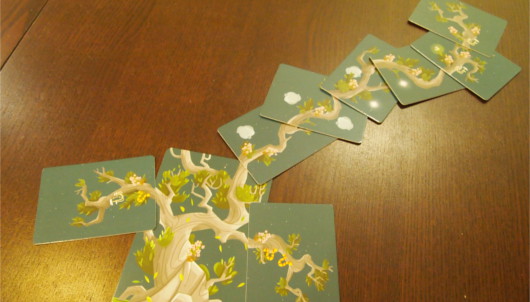Kodama: The Tree Spirits may sound like the latest album from a post rock band but this is actually a game from board gaming’s own new age artists. Featuring the undeniably quaint theme of growing a tree, Kodama astonishes with its ability to induce in you a zen like calm, even while fighting tooth and nail for the best cards. Come join me in finding fulfilment in the most unlikely of places. Really. It’ll grow on you.
• Designer: Daniel Solis
• Publisher: Action Phase Games, Capsicum Games, Indie Boards & Cards
• Number of Players: 2-5
• Playing Time: 40 mins

Every so often a game comes along that makes you sit up and take notice. That has passers by stop when they see that game spread out on the table and ask, “what are you playing?” Often such a game involves gigantic miniatures or other flashy components. When a little card game manages it? Then you know you’re on to something special!
But I know what you’re thinking. WTF is a Kodama? Well, it’s one of these fellows:

Such a cheerful chap! Or chap-ess, I guess… It’s a little unclear. Although that’s probably for the best given their lack of pants. A Kodama is a Japanese tree spirit, and s/he’s looking for you to grow a lovely new home for her or his (?) friends. You’re not going to leave them to struggle by on their own now are you? With that cute little face? Now, no suburban semi-detached will do them, they’ll need one of these:

See, I wasn’t kidding about growing a tree. Each player gets their own trunk to start off, then will pick up a branch card each round, adding it their existing tree and steadily growing it. This is a wonderful use of cards. The rules for placing are simple yet restrictive: the new card is placed partially over the top of an existing card, so that the branches pictured join up. Importantly, you mustn’t touch more than one card, limiting the density of branches to a comfortable degree, and your branches mustn’t go below the bottom of your trunk card, because that’s where the ground is! On the pro circuit, players will put their trunk against the table edge to remind them. It also, for some reason, looks better that way:

Weird, right?
But this wouldn’t be a game without some way of identifying who has the best tree and the Kodama have kindly provided thorough guidance on that issue. You see, Kodama don’t just want a dead husk to live in, it should be full of features! Between 2 and 3 features appear on each card. You have caterpillars (to eat), flowers (to pretty the place up), stars (to wish upon), clouds (to see shapes in), fireflies (to chase), and mushrooms (to get high off). Everything a Kodama might need for happiness!
When you add a card to your tree you score points for features that are shared along the cards on that branch. Better yet, you score a point for each matching feature through which you can trace an unbroken line of cards, from that card you just played. By carefully cultivating a branch you can score staggering amounts of points, even though it leaves you (ha! Leafs you) with some bizarre looking trees…

But a few things counteract this and drive your decisions throughout the game. Firstly, like all good horticulturalists, you pick up new branch cards from a market of four cards that are available each turn. This means it’s entirely possible for there not to be the perfect symbol combination for your tree available, especially if your friends are paying attention and grab the cards you want. It’s like fighting over the last flower in a garden centre. Trying to make the best out of a bad selection is a key challenge.
The other key challenge comes from your demanding Kodama friends. At the start of the game each player gets 4 Kodama cards that ask you to build your tree in certain ways. Like focussing on specific features or for getting as many cards as possible touching your trunk, say. Often these directly counter the “one massive branch” approach. For doing a good job with them you’ll get points! Which, interestingly, is what I pay my gardner in too.

Every few rounds you’ll have to pick one to score, which means you are constantly thinking about how to optimise and planning for the entire game. Scoring them in the best order for your particular combination and tree is hugely important, as is balancing these cards and the turn by turn scoring of features. There are also simpler, little Kodama cards that kids can play with to make this title fun and accessible for the whole family.
The one unfortunate downside to the Kodama cards is balance. You’ll find some cards are easier to get maximum points off than others, but the bigger issue is in the set of cards you get dealt. Sometimes your set of Kodama combo together exceedingly well, at other times they are tugging you in opposite directions and that just means you won’t be able to score as many points off them. This is mitigated somewhat by the fact that you only score 3 out of the 4, leaving one Kodama to their own devices, but annoyingly that only goes so far.

Fortunately, the game’s simple charm makes it a treat to play regardless of how well you’re doing. Steadily growing your tree across the table, choosing where to place new branches, these are immensely satisfying experiences in and of themselves. Scoring lots of points is really just a bonus. That’s a rare thing for a card game to achieve!
I have never had the pleasure of using cards in such an open and imaginative way before I played Kodama and now other card games feel so rigid and lifeless! So few games make you stop and reconsider how such basic components can be used. For that alone Kodama is worth experiencing! But it also treats you to a peaceful, satisfying game that falls only just shy of perfect.






